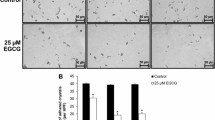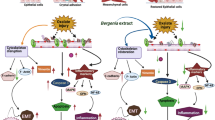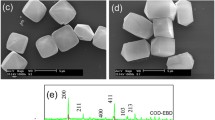Abstract
Alterations in intracellular Ca2+ ([Ca2+]i) are generally associated with cellular distress. Oxalate-induced cell injury of the renal epithelium plays an important role in promoting CaOx nephrolithiasis. However, the degree of change in intracellular free calcium ions in renal epithelial cells during oxalate exposure remains unclear. The aim of this study is to determine whether acute short-term exposure to oxalate produces morphological changes in the cells, induces a change in cytosolic Ca2+ levels in renal tubular epithelial cells and whether the application of extracellular glycosaminoglycans (GAGs) prevents these changes. Cultured Mardin-Darby canine kidney cells were exposed to oxalate, and changes in cytosolic Ca2+ were determined under various conditions. The effect of heparin and heparan sulfate (HS) during oxalate exposure was examined. The change in the GAG contents of the culture medium was also determined. Transmission electron microscopy (TEM) was performed for morphological analysis. The degree of change in cytosolic Ca2+ strongly correlated with oxalate concentration. Cytosolic Ca2+ levels decreased in parallel with an increase in the concentration of oxalate. However, this decrease was strongly inhibited by pretreatment with heparin or HS. TEM revealed cytoplasmic vacuolization, the appearance of flocculent material and mitochondrial damage after oxalate exposure. On the other hand, pretreatment with heparin or HS completely blocked these morphological changes. The present data suggest that acute exposure to a high concentration of oxalate challenges the renal cells, diminishes their viability and induces changes in cytosolic Ca2+ levels. Heparin and HS, which are known as potent inhibitors of CaOx crystallization, may also prevent oxalate-induced cell changes by stabilizing the cytosolic Ca2+ level.







Similar content being viewed by others
References
Balcke P, Zazgornick J, Sunder-Lassmann G, Kiss A, Hauser AC, Gremmel F, DerflerK, Stockenhuber F, Schmidt P (1989) Transient hyperoxaluria after ingestion of chocolate as a high risk factor for calcium oxalate calculi. Nephron 51: 32
Barsotti G, Cupisti A, Gervasi GB, Bartoli C, Barsotti M, Pasquariello A, Moriconi L, Giovannetti S (1999) Effects of oral administration of heparan sulphate in the rat remnant kidney model. Nephron 81: 310
Belliveau J, Griffin H (2001) The solubility of calcium oxalate in tissue culture media. Anal Biochem 291: 69
Dominguez JH, Song B, Liu-Chen S, Qulali M, Howard R, Lee CH, McAteer J (1996) Studies of renal injury II. Activation of the glucose transporter 1 (GLUT 1) gene and glycolysis in LLC-PK1 cells under Ca2+ stress. J Clin Invest 98: 395
Ebisuno S, Kohjimoto Y, Tamura M, Ohkawa T (1995) Adhesion of calcium oxalate crystal to Madin-Darby canine kidney cells and some effects of glycosaminoglycans or cell injuries. Eur Urol 28: 68
Farndale RW, Sayers CA, Barrett AI (1982) A direct spectrophotometric microassay for sulfated glycosaminoglycans in cartilage culture. Connect Tissue Res 9: 247
Finlayson B, Reid S (1978) The expectation of free and fixed particles in urinary stone disease. Invest Urol 15: 442
Gill WB, Jones KW, Ruggiero KJ (1982) Protective effects of heparin and other sulfated glycosaminoglycans on crystal adhesion to injured urothelium. J Urol 127: 152
Gokhale JA, Glenton PA, Khan SR (1996) Localization of Tamm-Horsfall protein and osteopontin in a rat nephrolithiasis model. Nephron 73: 456
Hammes MS, Lieske JC, Spargo BH, Toback FG (1995) Calcium oxalate monohydrate crystals stimulate gene expression in renal epithelial cells. Kidney Int 48: 501
Hautmann RE (1977) Intra-renal calcium and oxalate concentration gradients. In: Rose GA, Robertson NG, Watts RWE (eds), Oxalate in human biochemistry and clinical practice. The Wellcome Foundation, London, p 147
Heuvel LPWJ, Born J, Veerkamp JH, Velden TJAM, Schenkels L, Monnens LAH, Schroder CH, Berden JHM (1990) Heparan sulfate proteoglycan from human tubular basement membrane. Comparison with this component from the glomerular basement membrane. Biochim Biophys Acta 1025: 67
Iida S, Suzuki K, Matsuoka K, Takazono I, Shimada M, Inoue M, Yahara J, Noda S (1997) Analysis of glycosaminoglycans in human prostate by high-performance liquid chromatography. Br J Urol 79: 763
Iida S, Miyajima J, Suzuki K, Matsuoka K, Inoue M, Noda S (1997) Expression of heparan sulfate proteoglycan mRNA in rat kidneys during calcium oxalate nephrolithiasis. Urol Res 25: 361
Iida S, Inoue M, Yoshii S, Yanagaki T, Chikama S, Shimada A, Matsuoka K, Noda S, Khan SR (1999) Molecular detection of heparan sulfate proteoglycan mRNA in rat kidney during calcium oxalate nephrolithiasis. J Am Soc Nephrol 10: S412
Iida S, Peck AB, Johnson-Tardieu J, Moriyama M, Glenton PA, Byer KJ, Khan SR (1999) Temporal changes in mRNA expression for bikunin in the kidneys of rats during calcium oxalate nephrolithais. J Am Soc Nephrol10: 986
Khan SR (1995) Calcium oxalate crystal interaction with renal tubular epithelium, mechanism of crystal adhesion and its impact on stone development. Urol Res 23: 71
Khan SR (1997) Tubular cell surface events during nephrolithiasis. Curr Opin Urol 7: 240
Kohjimoto Y, Kennington L, Scheid CR, Honeyman TW (1999) Role of phospholipase A2 in the cytotoxic effects of oxalate in cultured renal epithelial cells. Kidney Int 56: 1432
Kok DJ, Khan SR (1994) Calcium oxalate nephrolithiasis, a free or fixed particle disease. Kidney Int 46: 847
Koul HK, Koul S, Fu S, Santosham V, Seikhon A, Menon M (1999) Oxalate: from crystal formation to crystal retention. J Am Soc Nephrol 10: S417
Koul H, Kennington L, Nair G, Honeyman T, Menon M, Scheid C (1994) Oxalate-induced initiation of DNA synthesis in LLC-PK1 cells, a line of renal epithelial cells. Biochem Biophys Res Commun 205: 1632
Lieske JC, Toback FG (1993) Regulation of renal epithelial cell endocytosis of calcium oxalate monohydrate crystals. Am J Physiol 264: F800
Lieske JC, Hammes MS, Hoyer JR, Toback FG (1997) Renal cell osteopontin production is stimulated by calcium oxalate monohydrate crystals. Kidney Int 51: 679
Lieske JC, Huang E, Toback G (2000) Regulation of renal epithelial cell affinity for calcium oxalate monohydrate crystals. Am J Physiol 278: F130
Moriyama M, Suzuki K, Nakajima C, Kawamura K, Miyazawa K, Tsugawa R (1994) Studies on the modified dimethylmethlene blue (DMB) method for determining glycosaminoglycans (GAG) in urine. Hinyokika Kiyo 40: 565
Mosmann T (1983) Rapid colorimetric assay for cellular growth and survival: application to proliferation and cytotoxicity assays. J Immunol Methods 65: 55
Scheid C, Koul H, Hill WA, Luber-Narod J, Jonassen J, Honeyman T, Kennington L, Kohli R, Hodapp J, Avazian P, Menon M (1996) Oxalate toxicity in LLC-PK1 cells, a line of renal epithelial cells. J Urol 155: 1112
Smith MW, Phelps PC, Trump BF (1992) Injury-induced changes in cytosolic Ca2+ in individual rabbit proximal tubule cells. Am J Physiol 262: F647
Suzuki K, Ryall RL (1996) The effect of heparan sulfate on the crystallization of calcium oxalate in undiluted, ultrafiltered human urine. Br J Urol 78: 15
Trump BF, Berezesky IK (1992) The role of cytosolic Ca2+ in cell injury, necrosis and apoptosis. Curr Opin Cell Biol 4: 227
Ueda N, Shah SV (1992) Endonuclease-induced DNA damage and cell death in oxidant injury to renal tubular epithelial cells. J Clin Invest 90: 2593
Verkoelen CF, Romijn JC, Cao LC, Boeve ER, Bruijn WC, Schroder F (1996) Crystal-cell interaction inhibition by polysaccharides. J Urol 155: 749
Verkoelen, CF, van der Boom BG, Romijn JC (2000) Identification of hyluronan as a crystal-binding molecule at the surface of migrating and proliferating MDCK cells. Kidney Int 58: 1045
Wiessner JH, Hasegawa AT, Hung LY, Mandel GS, Mandel NS (2001) Mechanisms of calcium oxalate crystal attachment to injured renal collecting duct cells. Kidney Int 59: 637
Yamaguchi S, Yoshioka T, Utsunomiya M, Koide T, Osafune M, Okuyama A, Sonoda T (1993) Heparan sulfate in the stone matrix and its inhibitory effect on calcium oxalate crystallization. Urol Res 21: 187
Yanagawa M, Koul H, Honeyman T, Malhotra R, Scheid C, Menon M (1994) Oxalate-induced changes in intracellular calcium levels in renal papillary cells. In: Ryall R (eds) Urolithiasis 2. Plenum Press, New York, p 117
Acknowledgments
This work was supported in part by a Grant-in-Aid for Encouragement of Young Scientists (S.I., M.I.:11770915, 11770916), (S.N.: 12307072) from the Ministry of Education, Science, Sports, and Culture in Japan. We thank Ms. Satoko Yamada for her help in preparing the cells for the transmission electron microscopic study.
Author information
Authors and Affiliations
Corresponding author
Rights and permissions
About this article
Cite this article
Iida, S., Ishimatsu, M., Chikama, S. et al. Protective role of heparin/heparan sulfate on oxalate-induced changes in cell morphology and intracellular Ca2+ . Urol Res 31, 198–206 (2003). https://doi.org/10.1007/s00240-003-0317-2
Received:
Accepted:
Published:
Issue Date:
DOI: https://doi.org/10.1007/s00240-003-0317-2




